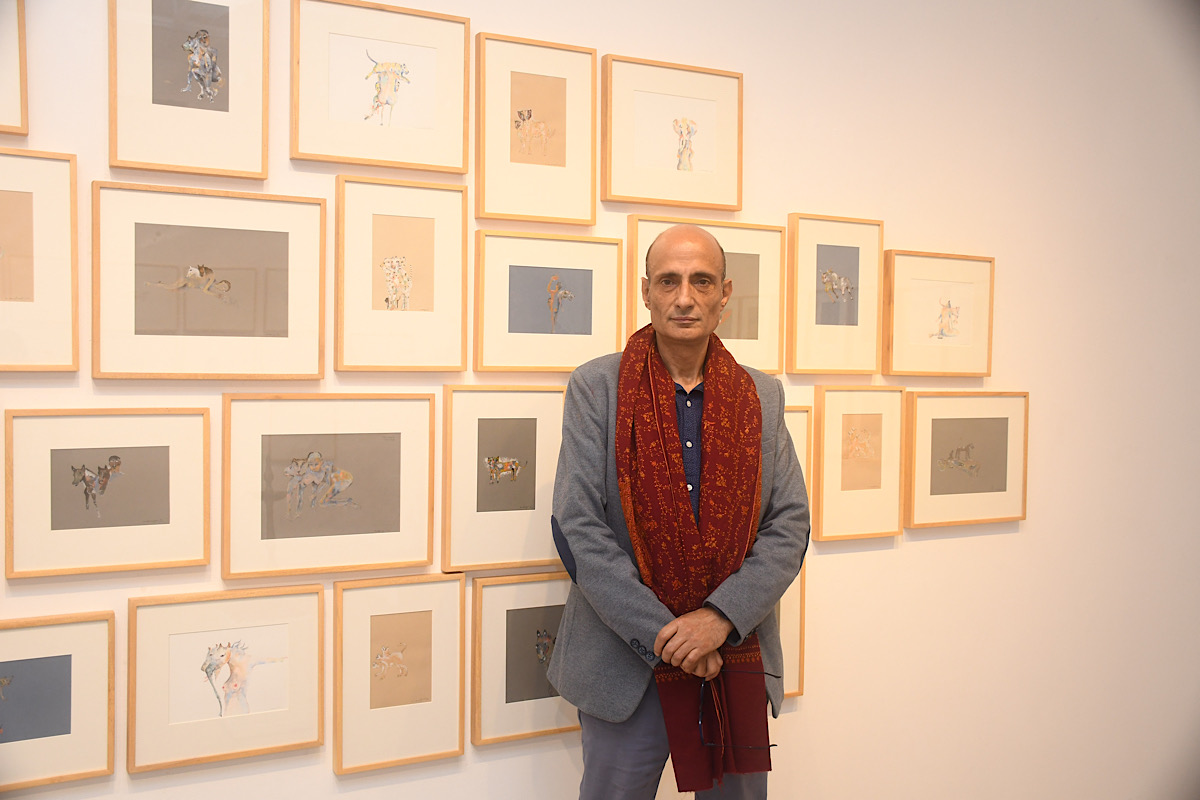A legacy comes alive through art
Avijit Dutta's unabashed passion and search for the buried stories and unravelled legacies of the spaces he inhabits have richly and evocatively surfaced in his art time and again.
Bakshi says animals have a special role in his theatre, as they seem to connect directly with the observer as the ardent human self, ‘breaking the fourth wall’.

Artist Neeraj Bakshi (Photo:SNS)
Small is beautiful, very often more so than large canvases. Playfulness, satire and a sensitive inventiveness — these are the words best used to describe an artist like Neeraj Bakshi whose work seems to float in an imaginary stratosphere, sometimes delineated only by fine brush strokes.
Bakshi says animals have a special role in his theatre, as they seem to connect directly with the observer as the ardent human self, ‘breaking the fourth wall’.
“I have always been fascinated by the feline family, be it cats or tigers, since childhood. Belonging to a landlord family, I spent my childhood in Jammu and Kashmir amid many domestic animals and huge farms. Cows, hens, goats, sheep — I have always been amused by the animal kingdom,” he says in a freewheeling interview to The Statesman.
Advertisement
“Besides, these paintings also highlight the crucial concepts of man-animal conflict and global warming. Animals, for instance bulls, signify vitality and vigour. The Japanese artists love horse designs,” he says.
His recent exhibition ‘Dreaming Animals’ in the city presented a captivating journey into the realm of intimacy and intricacy within small-scale formats. Bakshi’s artwork transcends mere aesthetic appeal, inviting viewers into a world where animals become conduits for personal narratives and universal emotions.
The exhibition showcased paintings of cats threatening to metamorphose into tigers and in the distance, sometimes beckoning the viewer to enter a fantasy world that is not necessarily as pretty as it seems like the Metatheatre of the Absurd.
As an artist who has grappled with displacement, Bakshi infuses his creations with layers of symbolism and nostalgia, evoking profound reflections on the human experience.
Talking about his style of working on small-scale formats, the 55-year-old artist says he was encouraged by acclaimed artist Anjoli Ela Menon to experiment with water colour.
“I do not confine myself to one ideology like many other artists. I experiment with theme and medium, and although I have worked mainly with oils, I have painted many watercolor sketches. In India, most of the artists and art buyers put their money on large canvases. These sell because their durability quotient is high,” he says.
Through his intimate creations on paper, Bakshi defies the belief that beauty is only found in larger canvases, proving that even the tiniest pieces can exude unparalleled allure. The artwork possesses a multitude of qualities that surpass mere aesthetic charm and fragility. The playful nature, satirical elements, and thoughtful creativity all work together to captivate and involve the audience.
The artist’s lyrical graphic poem is the result of an intense artistic exercise where words merely augment the seemingly innocent paintings of his oeuvre. Beneath the surface of these exquisite renderings is menace and nostalgia.
“By lyrical graphic poem, I mean some of my paintings flow like a poem or it is quite subtle, and of course open to interpretation. I feel a painting is not a simple illustration, it has a larger calling,” he adds.
Born in 1969, Bakshi completed his Bachelor of Fine Art from Kashmir University in 1992. His first paintings were landscapes of his own surroundings that offered so much inspiration to a fertile imagination. But whilst he was still studying, times changed for the worse, and terrorism invaded the Valley full force. This changed Bakshi as a person and an artist, shifting the focus of his paintings from peaceful landscapes to ghastly descriptions of suffering and pain.
He fondly remembers his visit to Africa, and how he toured the forests in the east of the continent. His entire perspective changed, and he became happier. This was reflected in his work, and the watercolors he had now adopted became colorful once again.
His figures mirror a definite Egyptian influence, and he now wants to tour that country and soak in its rich artistic and architectural heritage.
Asked how he sees his art, that is, a social tool or a medium of expression, Bakshi replies, “My art reflects my psychological and scientific temper. It is absolutely personal. I believe listening to one’s inner calling is crucial for creating art. I am also an avid reader. My readings of Sigmund Freud, Soren Kierkegaard, among others, also come through in my paintings.”
How much has his native place, Jammu and Kashmir, influenced his work?
“Jammu and Kashmir has always been present in my work. I have tried to explore the mythology and folklore associated with the region. In fact, my art is also my therapy,” he says.
Bakshi, who taught art at Amity University from 2003 to 2010, considers Mithu Sen as a promising artist among the current crop of creators for her non-conformist, multi-faceted practice encompassing painting, collage, installation, and performance.
On his next endeavour, Bakshi says he has set his eyes on a series on Egypt’s pyramids, trees and the natural landscape.
Advertisement